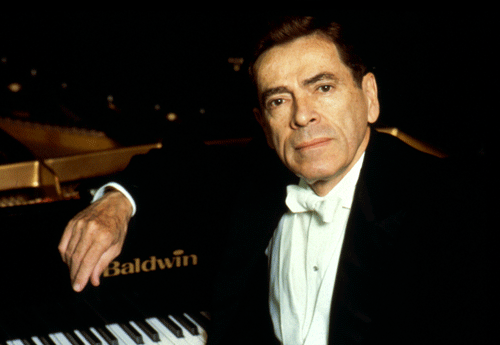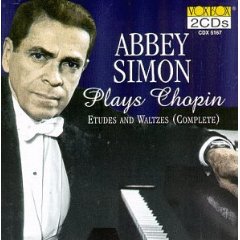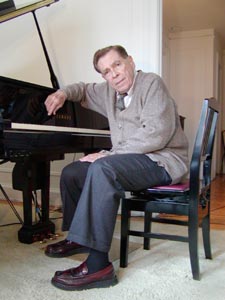Abbey Simon
An Appreciation
05/2009

I first saw the name Abbey Simon on the cover of a vinyl recording of Ravel’s Gaspard de la Nuit. That was nearly thirty years ago. I was living in a loft on skid row in downtown Los Angeles, spending my days setting type and my evenings painting and drawing. My stereo consisted of an Acoustic Research XA turntable that I modified to take an Infinity Black Widow tone arm, an NAD 1020 preamp, a JBL SA600 power amp and KEF 101 loudspeakers. There were no such things as audiophile cables, let alone audiophile power cords. Listening to music in that loft was a competition with car horns, drunken brawls, smashing beer bottles and loud mariachi music from two or three juke boxes, as well as live from a bar underneath my studio. Twenty one hundred square feet with fourteen foot ceilings and a skylight made it ideal for a painter. For an audiophile, it was just shy of impossible.
I practically wore out that record, which my girlfriend bought at Good Will for less than a dollar. I got to know Gaspard very well. And I came to appreciate Abbey Simon’s playing, preferring his measured and orderly precision to Martha Argerich’s fiery performance that I’d bought at Tower Records for a lot more than a dollar. It would be many years before I switched to compact disks and loaded up on a number of Mr Simon’s recordings of Chopin and Ravel and Schumann on the VOX label.
It was on an evening only a few years later, however, that I drove with my girlfriend to a college auditorium in the Pacific Palisades to hear Abbey Simon. I remember being impressed at the physical economy of his playing. I had expected that such dynamic pianism would require a certain flamboyance of motion and gesture. None of it. Which only served to make Mr Simon’s technique more impressive. We are almost all of us carrying baggage from our past, but the performing artist is someone who has continually worked on that baggage, the knowledge and experience from his past, like a sculptor constantly reworking the stone making it more and more perfect. Mr Simon’s decades-old performance in the Palisades was just another stepping stone for him, but for those of us in the audience, it was a privilege, it was an unforgettable connection with great music and great pianism.

The other night was blessed for me. The remarkable capability of the equipment and wires I’ve written about, combined with an unusual openness of mind and heart, provided several hours of ecstatic Chopin. I had not listened to Chopin for over a year and it was a sort of revelation: the Scherzi, Ballades, Etudes, Waltzes, and especially, the B-minor piano sonata, all played by Abbey Simon.
There are performances that convey an overwhelming sense of rightness, of being precisely what the composer intended, down to the smallest pause and grace note. There is sometimes a match between performer and music that leave you without a doubt, this is perfection. All other performances of Chopin paled in comparison. 
I never really understood Mr Simon’s preference for the Baldwin piano until then: it was ideally voiced for Chopin’s music. A Steinway would have been utterly different, and, I think, not as effective. (Mr Simon now favors a Yamaha CFIIIS and has a DS8 Pro Disklavier at home.) This was the greatest Chopin playing I’d ever heard. And like a performer who matures over time, it had taken me half a lifetime to arrive at such an appreciation.
It was all I could do to keep from dancing on the front lawn in the dark and cold rain. Practical considerations won out. I simply sat in the living room, smiling. All was right with the world.
Gratitude. How does one show gratitude for such an experience?
Mr Simon is now in his eighties, he’s still concertizing, he’s still thrilling audiences, he’s still appreciated by the cognoscenti. It’s one of those things, one of those disheartening facts of life that there’s room in the spotlight for only a few. Many, many great artists, painters, writers, singers, dancers, as well as musicians, remain under-appreciated. And it is our loss. If you believe that great art, great performance, enriches humanity, then it is our loss.
Over a decade ago Harold Schonberg wrote in the New York Times, “Mr. Simon has never been one of the big, publicized headliners, but his has been a solid, consistent career, and when he gives a recital – as he will on Sunday at 8 P.M. in Carnegie Hall – the audience will be full of professionals trying to figure out how those infallible fingers do this or that, how he gets the kind of color he does, and what he does with the rhythms to make them so flexible.”

Stereo Times Masthead
Publisher/Founder
Clement Perry
Editor
Dave Thomas
Senior Editors
Frank Alles, Mike Girardi, Russell Lichter, Terry London, Moreno Mitchell, Paul Szabady, Bill Wells, Mike Wright, and Stephen Yan,
Current Contributors
David Abramson, Tim Barrall, Dave Allison, Ron Cook, Lewis Dardick, John Hoffman, Dan Secula, Don Shaulis, Greg Simmons, Eric Teh, Greg Voth, Richard Willie, Ed Van Winkle, Rob Dockery, Richard Doron, and Daveed Turek
Site Management Clement Perry
Ad Designer: Martin Perry





Be the first to comment on: Abbey Simon